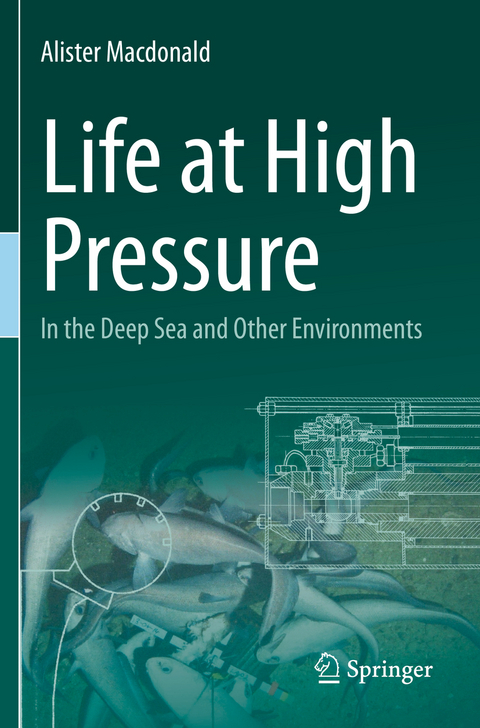
Life at High Pressure
Springer International Publishing (Verlag)
978-3-030-67589-9 (ISBN)
The book discusses the ways in which high hydrostatic pressure (i.e. water pressure) affects all grades of life which thrive at pressures much greater those in our normal environment. The deep sea is the best known high pressure environment, where pressures reach a thousand times greater than those at the surface, yet it is populated by a variety of animals and microorganisms. The earth's crust supports microorganisms which live in water filled pores at high pressure. In addition, the load bearing joints of animals like ourselves experience pulses of hydrostatic pressure of a magnitude similar to the pressure at mid ocean depths.
These pressures affect molecular structures and biochemical reactions. Basic cellular processes are drastically affected - the growth and division of cells, the way nerves conduct impulses and the chemical reactions which provide energy. Adaptation to high pressure also occurs in complex physiological systems such as those which provide buoyancy. Probably the greatest challenge to our understanding of adaptation to high pressure is the stabilisation of the nervous system of deep sea animals to avoid convulsions which pressure causes in shallow water animals.
Additionally the book provides insight into the engineering required to study life at high pressure: equipment which can trap small deep sea animals and retrieve them at their high pressure, equivalent equipment for microorganisms, laboratory microscopes which can focus on living cells under high pressure, incubators for bacteria which require high pressure to grow, high pressure aquaria for marine animals and lastly and briefly, manned and unmanned submersible vessels, Landers and deep drill hole sampling. Rather like the organisms studied many laboratory instruments have been adapted to function at high pressure.
lt;p> Dr. Alister Macdonald graduated in Zoology at Bristol University. After post doctoral research at the University of East Anglia he moved to Aberdeen University, becoming Reader In Physiology in 1984. His work on deep sea animals with Dr. I Gilchrist tackled the recovery of small animals without decompression, their tolerance to pressure and recovery from decompression paralysis. Additionally, he demonstrated homeoviscous adaptation of deep sea fish membranes to high pressure. Work at sea alternated with laboratory studies of cellular processes at high pressure; membrane bilayers, membrane bound enzymes, ionic regulation, electrophysiology - latterly patch clamp studies of various ion channels and of anaesthetic - ion channel interactions. Collaboration with much valued students and senior colleagues was a key part of this wide range of activity, involving The Woods Hole Oceanographic Institution (USA) and the Bermuda Marine Biological Station for Research, The Rowett Research Institute and the Marine Laboratory, (both in Aberdeen), Queen's University, Belfast, Brunel University, and the Universities of Liverpool, Nottingham, North Carolina and Western Australia, The Babraham Institute, Cambridge, and the Max-Planck Institute for Biophysical Chemistry, Göttingen, Germany.
High pressure and High pressure environments.- High pressure: molecules, chemical processes and cellular structures.- The high pressure micro-environment of vertebrate load bearing joints- Effects of high pressure on the activity of ordinary animals, including humans, and on the function of their excitable cells and ion channels.- The effects of decompression and subsequent re-compression on the activity of deep sea animals and eukaryote cells. The isobaric collection of deep sea animals.-Molecular adaptation to high pressure: proteins in deep sea animals.- Molecular adaptation to high pressure: membranes.- Prokaryotes at high pressure in the Oceans and the Deep Biosphere.- Hydrothermal vents: the inhabitants, their way of life and their adaptation to high pressure.- Buoyancy at depth.- Divers: Air breathing animals, including humans, at high pressure.- Adaptation to high pressure in the laboratory.- High pressure equipment used in the laboratory, at sea and at depth.
| Erscheinungsdatum | 15.07.2022 |
|---|---|
| Zusatzinfo | XVII, 445 p. 62 illus., 19 illus. in color. |
| Verlagsort | Cham |
| Sprache | englisch |
| Maße | 155 x 235 mm |
| Gewicht | 706 g |
| Themenwelt | Naturwissenschaften ► Biologie ► Ökologie / Naturschutz |
| Naturwissenschaften ► Physik / Astronomie ► Angewandte Physik | |
| Schlagworte | buoyancy at depth • cell under high pressure • diving at high pressure • high pressure environment • high pressure under experimental conditions • landers • microorganisms under high pressure • moleculs at high pressure • organisms under high pressure • submersibles |
| ISBN-10 | 3-030-67589-0 / 3030675890 |
| ISBN-13 | 978-3-030-67589-9 / 9783030675899 |
| Zustand | Neuware |
| Haben Sie eine Frage zum Produkt? |
aus dem Bereich


